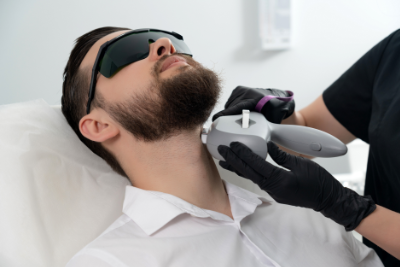Laser Therapy
at CHC
Cold Laser Therapy, also known as Low-level (light) laser therapy (LLLT), is currently being used as a treatment and therapy, worldwide. While the public’s familiarity with this approach is limited, the fact that LLLT is effective, safe, and affordable, is helping to increase its use.
At Cherubino Health Center, we began using an early form of LLLT in the mid 1990s. Originally used to treat acupuncture and nerve points, we are now using the latest forms of Cold Laser Therapy to assist with the treatment of a wide range of conditions. We find it to be highly effective both as a stand alone treatment and an adjunctive therapy.
LLLT – Low Level (light) Laser Therapy, effects and uses:
- Anti-inflammatory effect
- Pain relief
- Swelling and edema reduction
- Restoration of function
- Neuritis, Neuropathy
- Arthritis
- Skin conditions
- Hair restoration
- Laser Acupuncture
- Meridian point treatment
- Poor circulation
- Tendonitis
- Wound healing
- Disc problems

About Laser Therapy
The discovery of Laser in 1960 opened up new prospects for the medical use of light. Lasers now provide the clinician with optically pure sources of light that is capable of producing specific photochemical and photoelectrical reactions.
Since 1971 thousands of papers have been published around the world concerning the physiological effects of low power laser. Low power laser therapy has emerged as an important treatment modality and has been shown to be effective for the treatment of a variety of conditions.
Research has demonstrated significant positive effects with cold laser therapy (635 – 690 nm) on cells, tissues, organs, and other structures. For example, when nerve points are stimulated, sympathetic and other afferents (nerves that conduct impulses to the spinal cord) transmit information to the central nervous system.
Nervous System Improvements
Researchers have demonstrated therapeutic changes to the central and peripheral nervous systems in patients following laser therapy. The laser penetrates the epidermis, dermis and sub-cutaneous layers, entering the flexor tendons and surrounding tissues. Along its path the laser deposits photons into the cells.
Nerve stimulation is immediate. Within minutes microcirculation is improved bringing increased oxygen and blood flow into the area. The laser beam also blocks pain enzymes and activates the synthesis of endorphin enzymes.
Biologically, the laser light will increase the cell production rate in connective, tendinous and cartilaginous tissue. In addition, the laser beam has the capability of increasing the rate of regeneration of nerve cells and will not stimulate bacterial growth or cancerous tissue.
